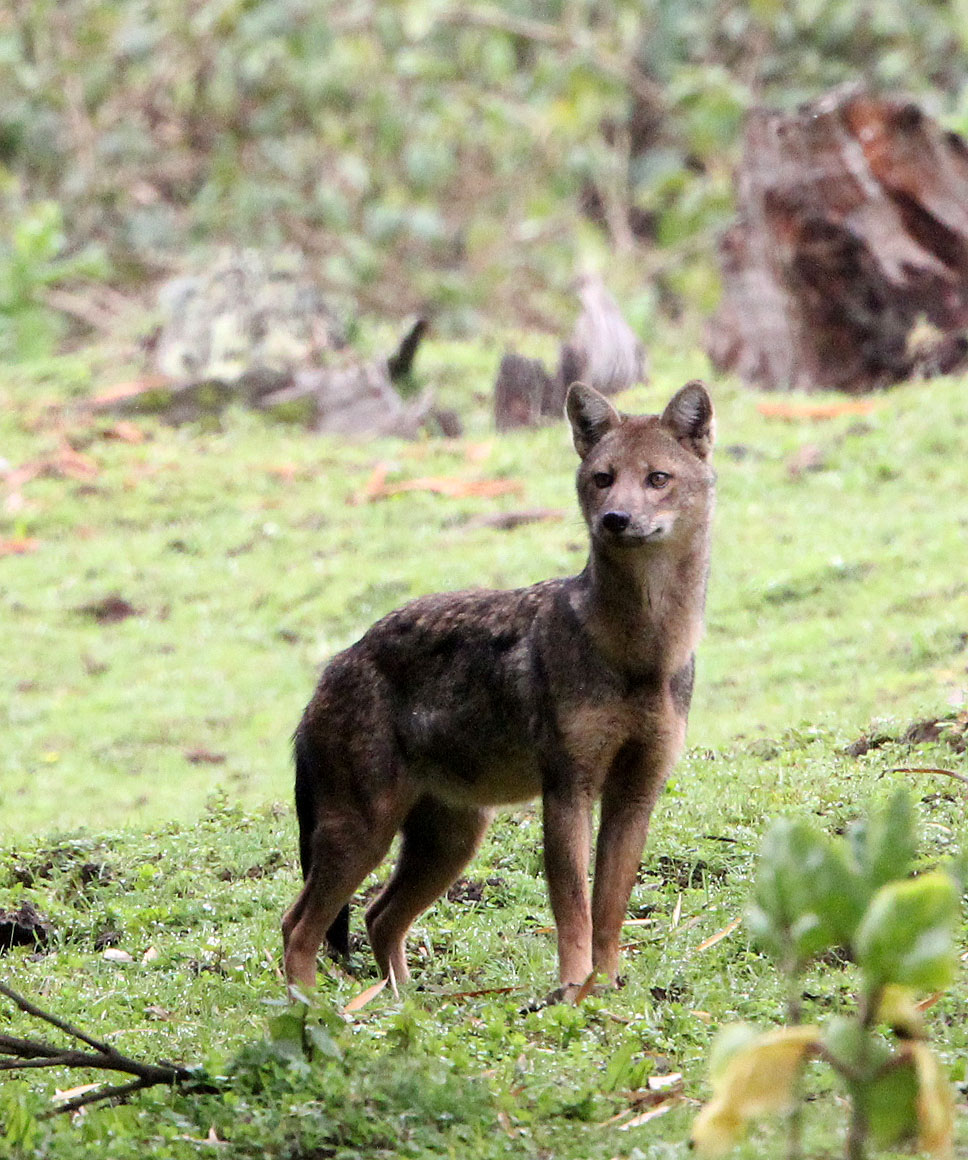Very Strange Canid in Bale Mountains Ethiopia (RFI)

While in the Bale Mountains (Harenna Forest to be exact), we came across this very different Canid. Initially we ID’d it as Canis aureus but clearly it is not. Perhaps a hybrid? I would love to hear everyone’s thoughts on what it might be.
22 Comments
-
-
-
-
Vladimir Dinets
There is definitely some Ethiopian wolf blood involved, because no other species has this chest pattern. I’ve seen an African wolf in Bale, and it didn’t look even remotely similar.
-
-
Steven Olson
snout and ears appear less pointed than either common jackal or Ethiopian wolf. Neck appears longer.
-
-
Vladimir Dinets
My guess would be Ethiopian wolf x striped jackal hybrid, but there are other possibilities. It could also be a pure Ethiopian with somewhat unusual coloration.
-
-
Claudio Sillero
Definitely a jackal, but whether it is the same Canis aureus we have in the northern slopes and main massif of BMNP is difficult to say. We have recently described a rather cryptic “African” wolf (from Arsi and North Ethiopia material), which can’t be easily distinguished from Canis aureus, and this might just be it.
The head looks uncanningly just like Canis adustus (side-stripped jackal) which is found at lower altitude further south, although the side stripe is not noticeable. I do not think this is a hybrid.
Do we have a precise location, with altitude?
Claudio Sillero
IUCN Canid Specialist Group -
Coke Smith
We came across this individual a bit past the ranger station heading down from Rira village at the beginning the Harenna forest, bamboo-Bale Monkey habitat. The photographs were taken in a cleared field as the animal was heading across the road. He paused and gave us a very good look before heading to the east. Try these coordinates: 6.755519,39.72182 I am not sure of the elevation but it was just a bit lower than Rira. I don’t think it would be too hard to find out the elevation but I don’t know. I will post some images in a followup post.
-
Coke Smith
OK – here are all of the images of the mystery jackal that I was able to get. Perhaps they may be more informative. I did put some images of C. aureus that I took in the Simiens for comparison – everything is clearly labeled. I would LOVE to hear more! Thanks for taking the time.
-
-
Jean-Marc Lernould
Hi Claudio and Frank,
I agree with you that this canid photographed near Rira is probably a side-striped jackal, confirmed by the other pictures sent by Coke Smith.
I have seen pictures of such a canid, a road kill, near Jimma.However : Neumann described Canis kaffensis in 1902 as differing from side-striped jackal. He mentions two specimens sent from Addis Ababa living in Frankfurt zoo which did not exhibit side stripes permanently, suspecting this to be related to age or season.
Perhaps this canid on the pictures of Coke Smith corresponds to C. kaffensi. And it might be a species different of C. adustus.-
Steven Olson
Yes, looks right for a side-striped. Check out also http://www.canids.org/species/Canis_adustus.htm
-
-
-
Frank Vincent
The African wolf, looks more like a smaller version of North America’s ancient Red wolf , at least in the northern part of its range, the desert version of African wolves does look more like Arabian wolves, I’m convinced that this is a side-striped jackal,of which are cryptic and rarely seen, so they appear unfamiliar, great photo
Frank Vincent
Wild Dog Foundation -
Karen Laurenson
This is a great photo. I think I have also seen this canid near Dinsho in Bale (years ago and i wondered if a hybrid too) and also here in Addis Ababa in the last month. Its probably the ‘African wolf’ but it does have head charatcteristics of a side stripe jackal its true. Convergent evolution? I’ll try and get some photos and scats from Addis and connect with Anagaw to do the genetics
Karen Laurenson, FZS,-
Jean-Marc Lernould
Please look at :
http://www.cepa-association.org/magazines/cepa_mag_23_DEF_LIGHT.pdf
page 3 for my photos taken in 1967 near Dinsho.
I thought it was Canis aureus at that time, with thick fur due to altitude.For me a different canid from the one photographed by Smith, especially if looking at the other photos he took of that individual.
I think that “my” jackal could be the African wolf.
Let us hope that Anagaw will help understanding these taxonomic issues with genetics.
Jean-Marc Lernould
-
Simon Langan
Karen, met one on the ILRI campus today here in Addis, as a non zoologist it looked pretty similar to photo, perhaps a broader snout and not so noticeable dropped hind legs as in jackal. S
-
-
Charles Foley
I would agree with the Side striped jackal verdict. At first glance its certainly not what springs to mind, but I checked it against our photo database for Tanzania and both the body proportions and patterning on the throat, chest and sides match for this species. It is a very peculiar colour though.
Charles Foley
WCS -
Jon Hall
Some more comments are here on a different thread http://mammalwatching.wordpress.com/2014/09/24/new-trip-reports-scotland-borneo-way-kambas-and-ethiopia/#comment-4006
jon
Leave a Reply
You must be logged in to post a comment.


Vladimir Dinets
Chest pattern is typical for C. simensis, which is very common on the plateau above Harenna Forest. But the body coloration and proportions seem a bit off, and I’ve never heard of them descending into the forest. Considering that there are six (!) species of Canis in the Bale Mountains, a hybrid is possible… but I don’t think you can get a definitive answer from the photo.